''Plasma Crystal''
Latest News!
|
December 2012
Note! 'Plasma Crystal Latest News'
will be terminated
Please visit the new MPE
homepage for latest news about the Theory/Complex Plasma group.
Thank you very much for your interest.
|
September 2012
|
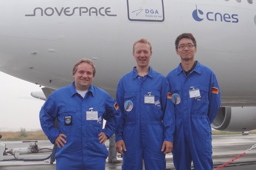
Day 1 crew: Michael, Ralf, Chengran
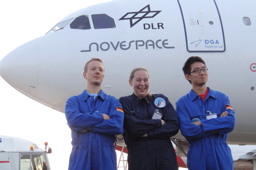
Day 2 crew: Ralf, Lisa, Chengran
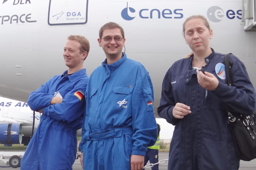
Day 3 crew: Ralf, Slobodan, Lisa
(All pictures courtesy of Michael Kretschmer)
|
PlasmaLab: Third Parabolic Flight Campaign
For the third time PlasmaLab - the next-generation MPE experiment
with complex plasmas in microgravity - was elected to take part in a
parabolic flight campaign of the German Aerospace Center
( DLR) in Bordeaux, France.
Eight MPE staff members were there to mount and test the hardware in the
aircraft and perform experiments in flight. DLR) in Bordeaux, France.
Eight MPE staff members were there to mount and test the hardware in the
aircraft and perform experiments in flight.
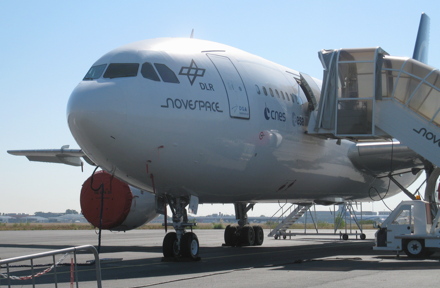
Lead by Dr. Christina Knapek this time the test program included the newly
developed Zyflex and Dodecahedron plasma chambers (see pictures
below), and also the new 4-channel high-frequency generators. The Zyflex
chamber is a plasma chamber with cylindrical and flexible
geometry. The Dodecahedron is a nearly spherical plasma chamber with 12
electrodes made out of glass to create a spherical and isotropical plasma.
Both chambers are to study complex plasmas in microgravity in an expanded
parameter range.
The PlasmaLab project is to continue the successful series of complex plasma
laboratories of the MPE onboard the International Space Station ISS (PKE-Nefedov
(2001-2005), PK-3 Plus (2006-2013), PK-4 (launch in 2014)).
It is supported by DLR.
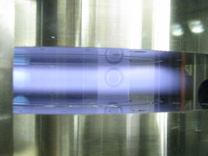
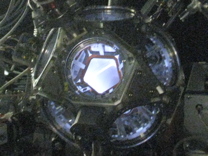
Zyflex (left) and Dodecahedron (right) plasma chambers.
|
February 2012
|
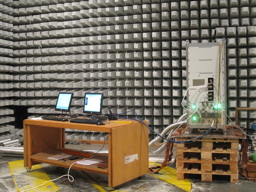
EMC Tests at SGS, Munich
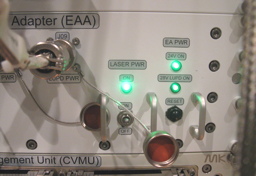
PK-4 EAA (Detail)
(Pictures courtesy of MK)
|
PK-4: EMC tests passed!
MPE's PK-4 experiment has taken another milestone on its
way to the ISS. Before launch the European Space Agency (ESA) requests
the proof that the device does not interfere with other devices (experiments
or safety-related components) onboard the Space Station through
electro-magnetic radiation, nor gets disturbed by the radiation of
devices around. This is called EMC: Electro-magnetic compatibility.
This test was done with the 'engineering model' (the precursor of the
final 'flight model') of PK-4 at
 SGS in Munich.
(See picture on the left: PK-4 integrated into an ISS-like rack structure
inside a shielded testing room at SGS.) SGS in Munich.
(See picture on the left: PK-4 integrated into an ISS-like rack structure
inside a shielded testing room at SGS.)
At this test the radio frequencies that are emitted by the device in
operation are measured. This allows the conclusion whether surrounding
devices may be effected or not. At the next test some powerful radio waves
are 'shot' with antennas at the apparatus and the reactions are observed.
Since PK-4 records videos of micro-particles inside a plasma the video
images are inspected carefully as an indication of inference.
The first test did not show up any significant emissions from PK-4 in
the range between several Kilohertz and a few Gigahertz. This was
expected because the experiment setup is enclosed inside a hermetically
sealed metal container where no electro-magnetic radiation is supposed
to come out. And for the opposite direction it is the same. Despite of
radiating powerful radio waves onto PK-4 with frequencies up to 4 GHz
during operation no interference could be observed. Because it would
be most obvious in the video recordings the images (see below) were
analyzed but no changes have been found. This allows us to say: Test
passed successfully!
After passing the vibration test in December, the thermal test in January,
and the EMC test now the next step will be the integration test. This
will be done at the ground model of the EPM rack at
 CADMOS in Toulouse,
France, where everything has to 'fit'. The future flight model of PK-4
is planned to be integrated into the EPM rack inside the European Columbus
module
on the space station. If all these tests are passed successfully this
will open the way to a launch to the ISS in 2013-14. CADMOS in Toulouse,
France, where everything has to 'fit'. The future flight model of PK-4
is planned to be integrated into the EPM rack inside the European Columbus
module
on the space station. If all these tests are passed successfully this
will open the way to a launch to the ISS in 2013-14.
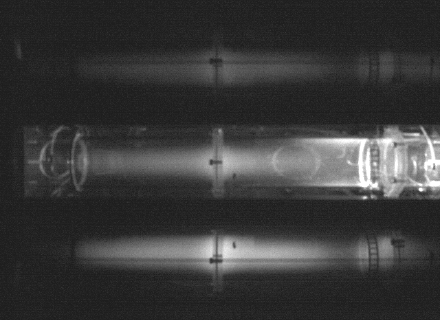
No interference: The PK-4 plasma tube seen clearly through three
different filters during the EMC test.
|
Updated: 2013-02-08
Contact: Michael Kretschmer

|